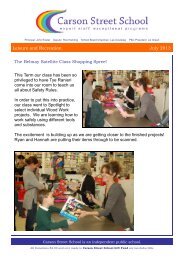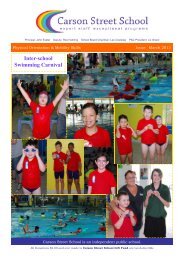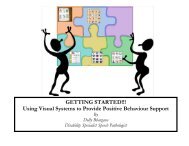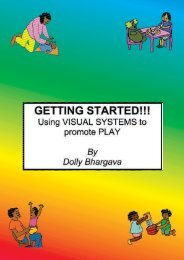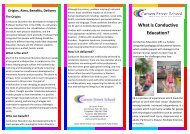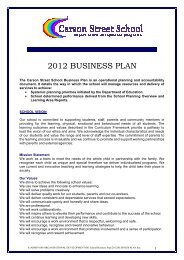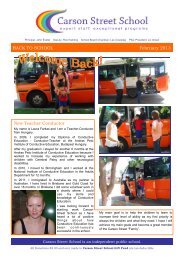Getting Started: Using Visual Systems to Promote Communication
Getting Started: Using Visual Systems to Promote Communication
Getting Started: Using Visual Systems to Promote Communication
You also want an ePaper? Increase the reach of your titles
YUMPU automatically turns print PDFs into web optimized ePapers that Google loves.
7<br />
Topic 3 - What are the different types of visual supports?<br />
Least abstract/ Iconic<br />
/Easy <strong>to</strong> understand<br />
/recognise<br />
START HERE<br />
1..Objects refer <strong>to</strong> the use of everyday objects from an activity for communication. Objects can<br />
represent an activity, location, and person. For example, <strong>to</strong> inform the child its time <strong>to</strong> eat show them<br />
their plate or its time <strong>to</strong> go swimming show them their swimming costume or its time <strong>to</strong> go <strong>to</strong> grandma’s show<br />
them grandma’s scarf that looks like the scarf grandma always wears.<br />
Object symbols are a step up from using everyday objects as the child needs <strong>to</strong> associate the<br />
object symbol with an activity/location/person. An object symbol is made by using an object that<br />
is associated with the activity and Velcroing it on<strong>to</strong> a cardboard or laminated sheet. For example, a<br />
mouse <strong>to</strong> represent a computer activity or a packet of crackers and cheese <strong>to</strong> represent morning tea.<br />
Morning tea<br />
Computer<br />
and depending your<br />
child’s response<br />
gradually progress <strong>to</strong><br />
2. Pho<strong>to</strong>s refer <strong>to</strong> the use of pho<strong>to</strong>graphs for communication. This includes non-digital and digital<br />
pho<strong>to</strong>s, Polaroid pho<strong>to</strong>s, pictures cut out from magazines, catalogues etc. Pho<strong>to</strong>s can represent<br />
people, activities, places, objects (food, drinks, <strong>to</strong>ys, grooming/personal hygiene, clothes).<br />
Bed<br />
Mum<br />
Vegemite sandwich<br />
HERE if appropriate<br />
3. Computer line drawings refer <strong>to</strong> the use of coloured or black and white line drawings (hand<br />
drawn or commercially produced). Examples of commercially available programs include Clipart,<br />
Boardmaker, Softpics with Fantasticpics, COMPIC etc. These pictures can be easy <strong>to</strong> recognise<br />
(iconic/least abstract) <strong>to</strong> difficult <strong>to</strong> understand (abstract). As you can see below a computer line<br />
drawing of an apple or an aeroplane is easier <strong>to</strong> recognise compared <strong>to</strong> a feeling (for example,<br />
angry) or an action (for example, washing face). If you use abstract drawings you will need <strong>to</strong> teach<br />
their meaning (i.e. help your child make the association between the concept in real life and the<br />
drawing.<br />
Coloured + Iconic Black & white +Iconic Coloured + Abstract Black& white +Abstract<br />
apple<br />
aeroplane<br />
angry<br />
Washing face<br />
Most abstract/<br />
Most difficult <strong>to</strong><br />
understand/recognise<br />
4. Written word refers <strong>to</strong> the ability <strong>to</strong> read and understand the words.<br />
My morning routine<br />
1. Go <strong>to</strong> the <strong>to</strong>ilet<br />
2. Wash hands<br />
3. Brush teeth<br />
4. Wash face<br />
5. Comb hair<br />
6. Eat breakfast



